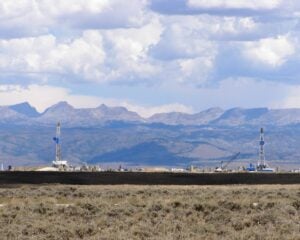Wyoming is at a crossroads moment for methane that may decide its energy future
Wyoming stands at a crossroads that will determine the future of the state’s energy industry. In front of the state lie two paths for how to implement rules for methane emissions from oil and gas production, and leaders in Wyoming need to decide which direction the state will go.
One path is to stand by while neighboring states adopt measures that make their state more competitive and improve air quality– issues that Wyoming has a history of leadership on, notably their requirements for green completions, strong new source rules and pioneering rules to protect air quality and reduce emissions in the Upper Green River Basin. This path may be simpler in the short
term, but in the long term it risks Wyoming’s industry being left behind in a future where international energy markets are demanding cleaner sources of energy, and Wyoming’s oil and gas producers can’t compete with those other states that implemented tighter standards.
Wyoming is at a crossroads moment for methane that may decide its energy future Share on XThe other path is to draft and adopt strong methane rules for both new and existing oil and gas wells that will lead to a more reliable future for the state’s energy industry, save taxpayers money and reduce the health harms associated with methane emissions that are affecting people in Wyoming. It’s not going to be as simple though, and it’ll take great leadership to push this process all the way to the finish line.
Fortunately, Wyoming has already taken significant steps towards that second future by scheduling meaningful engagement sessions for existing sources, and we’re excited to see how the Wyoming Department of Environmental Quality can follow through to deliver meaningful progress, on new sources, for their state on October 23.
Some quick background on how we got here:
In 2023, the United States Environmental Protection Agency finalized a groundbreaking methane rule requiring every oil- and gas-producing state to draft methane protections for two kinds of oil and gas facilities: new sources and existing sources.
“New sources” applies to wells that were constructed or modified after Dec. 6, 2022. Controlling methane from new sources is something that the oil and gas industry has identified as an important goal and made commitments to do. The exciting new component of the EPA Methane Rule is the additional requirement to craft rules for “Existing Sources” (any well constructed before December 6, 2022). This component is what makes the rule a bit more complex, but it is also exactly what will prepare state energy industries to be globally competitive and deliver on significant emissions reductions.
Drafting a rule like this requires a ton of details, and it requires a democratic process so all involved stakeholders can have their input. These processes are, by necessity, time-consuming, but methane emissions are a pretty urgent issue in Wyoming.
In 2023, EDF conducted an aerial survey of more than 70% of U.S. oil and gas onshore production. In an analysis released earlier this summer, we found that oil and gas operations in the Greater Green River Basin had the third-highest methane loss rate in the nation. Since methane is the primary component of natural gas, when methane emissions occur Wyoming schools, taxpayers, and royalty owners lose out on millions in lost tax revenue. This is a needless waste of Wyoming resources that could instead have heated homes this upcoming winter.
With that urgency to act in mind, the DEQ recently announced it will hold a meaningful engagement session on Oct. 4 for the existing source rule, the second such state to do so. They’ll hold seven total in-person sessions around Wyoming throughout October and a new source hearing on Oct. 23, creating many opportunities for stakeholders to give their input so the process can end with two effective rules that deliver great results for the state’s economy and cleaner air for its communities.
Governor Gordon has called for a diverse and productive energy industry, and showing leadership here is a great way to follow through on that goal. The DEQ can ensure that the state’s oil and gas producers are ready to comply with more serious international methane standards, and that the booming methane mitigation industry will continue to create good-paying jobs around Wyoming.
Crossroads are more important than paths because they require a choice. Following a path may not always be easy, but it doesn’t take the same kind of leadership as looking at two potential ways to go and deciding which one must be taken. Wyoming is at one of those decisive moments right now, and so far its leaders are showing themselves to be ready for it.
[Photo by BLM Wyoming]











